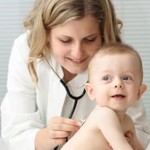Infant Pneumonia Symptoms & Treatment
 What is Pneumonia ?
What is Pneumonia ?
Pneumonia is a disease spread by virus or bacteria and infects the lungs and obstructs the free flow of oxygen.
The air that we breathe contains oxygen. This oxygen is filtered by the lungs. This is dissolved in the blood through alveoli which are small air sacs that surround the blood vessel. Then the red blood cells distribute the oxygen to the rest of the body.
Pneumonia causes in children
Bacteria are the most common causes of pneumonia, infections, but it can also be caused by other micro-organisms. It is often impossible to identify the specific culprit.
Many bacteria are categorized by the laboratory procedure used to visualize bacteria under a microscope. Bacteria are stained to determine whether they were Gram-negative and Gram-positive bacteria. This gives the physician an idea of the severity of the pneumonia and treated as different bacteria are treated with different drugs.
How does it occur ?
When pneumonia occurs, the functionality of the lungs is impaired as the infection causes fluid formation. These fluids are a hindrance to the blood flow. Thereby the oxygen cannot get to the bottom of the lungs and as a result lesser oxygen is supplied to the blood. The case becomes even more severe when the both the lungs are affected with pneumonia.
Types of pneumonia
-
Double Pneumonia
When both the lungs are affected
-
Walking Pneumonia
If the infection is no severe and the child is able to get on with its day to day activities
Who gets affected ?
Pneumonia can affect the young and the old. People who suffer from cold or flu are more susceptible to Pneumonia as their immunity is not very high at that of point time. The bacteria and virus that cause pneumonia can easily get into the lungs and cause infection. Contrary to the popular belief, getting wet in rain or pool will not cause pneumonia.
Pneumonia Signs & Symptoms
If Pneumonia occurs due to bacterial infection, then the child will get high fever followed by chills. This occurs soon after the infection occurs.
For viral infected pneumonia, the symptoms take time to show up. The child would complain of cough, chest pain, headache, and or muscle ache. There would be loss of appetite as well. Also, the breathing may be faster and the child may cough out gloppy mucus.
How to treat pneumonia ?
For walking pneumonia, simple medication at home is sufficient. But if it’s not manageable at home, a visit to the doctor is essential. The doctor would check the heartbeat and breathing. Bubbling or crackling noise of the heartbeat indicates presence of fluids and therefore pneumonia. At time chest X-ray would be needed. Chest X-ray would help in determining whether it’s a viral or bacterial infection. The white patchy area in the x-ray would indicate the presence of fluids. For bacterial infections, antibiotics are the cure. If the child throws the medicine, then it may have to be injected through IV fluid. For viral infections, fever reducers and cough medicine is the cure. However, in both cases, intake of plenty of fluids and lots of rest is essential.
Prevention
To prevent the occurrence, kids can be immunized by giving them pneumococcal shots. Kids who have history of asthma or other kinds of lung infection could have the normal flu injections. Cleanings hands and legs regularly can prevent the occurrence of infections. Above all, adequate rest and sleep makes the immune system stronger.